ISSN ONLINE(2278-8875) PRINT (2320-3765)
ISSN ONLINE(2278-8875) PRINT (2320-3765)
Suresh S1, Mrs. L. Sheela M.E (PhD)2
|
| Related article at Pubmed, Scholar Google |
Visit for more related articles at International Journal of Advanced Research in Electrical, Electronics and Instrumentation Engineering
Automation has become more important in many of the application like plant monitoring, home automation, and sensor and actuator integration. Presently automation vendors like ABB, LANCIER, CA, provide tools for these applications are efficient for the large scale automation. In this project we address local automation problem, due to different controllers and tools where there is no integration schema. Each of the local users is in need of web address for controlling the device remotely. Commercial web server modules are available which need the hosting or can be accessed through the IP address. Different product development leads to lack of web standardization. To give an elucidation to this inconvenience a unified monitoring approach is introduced in this scheme. It uses interoperable web service for all users to afford an open source web service with personalized GUI. Security policy and Base-station-level system integration are of prime concern. The web service run different services namely, Database service, User management service, Unified Display service, Configuration service, Web admin service. The access definition of each service is modeled by Unified Modeling Language (UML).
Keywords |
| Automation, Web service, Open Source Website, unified motoring, Smart Home |
INTRODUCTION |
| Web technology endow with simplest static page to more sophisticated dynamic page which connect to the database for application like internet application, electronic banking. This paper deals with the state of home automation which is referred to local automation. The eagerness towards automation of home through internet is a great conjure. Home automation includes the monitoring of household activity and controlling the appliances. Comparing with Industrial automation use robotic devices to entire manufacturing tasks. It is becoming increasingly imperative in manufacturing process because computerized or robotic machines are capable of handling repetitive task quickly and efficiently. They employ large PLC, SCADA, and HMI systems to control this activity. The efficiency of industrial automation is measured in terms of accuracy, but in case of home automation the user need cost efficiency at their prime concern. |
| The integrated monitoring system takes the advantage of networks technologies. The integrated monitoring systems are more important for investigation, detection and policy decision in many fields [1]. The integrated monitoring is more beneficial than single measurement in a local system. Home automation systems that are implemented are of single measurement and controlling is done through IP address. This infrastructure state have to use static addressing, the cost of static addressing very high since cannot be suitable for the home automation. The embedded controller with the Ethernet connectivity available in market can be used for this purpose need high operating cost. |
| The previous works in the integration architecture mainly focuses on high-end systems with eddied wireless sensor nodes. They provide new availabilities for the control and monitoring appliances. The implementation done using the SOAP based web service [2]-[3].This paper polymorph the unified web service for the IEEE1451 smart transducers, which provide a standardization way for sensor application to access and interoperate with smart transducers [3]. |
| The growing demand for the new service on the internet, the network control plane has evolvers in ISP networks through much generation. The major issues facing are the scalability and the flexibility in cloud computing services [4]. The cloud computing have may service architecture to run efficiently, this paper inspire this service to make use in the home automation. |
| In [5], we described a layered model and given an approach for simplifying software development. We developed a system for integrating all home user to single monitoring system in this paper, in which user can access the data from different home with the security policy described later in this project. The customizable GUI is developed for the user that unified and more interactive compared to the commercial products. The home automation needs fetching of the energy meter value to monitoring station, the monitoring station provide a database to store these values. The database has greater advantage in serving monitoring system. Today most of the dynamic websites run the database server at the back end and the front panel is well designed to represent the data in the database. Similar approach is followed in this paper; all users are provided with secured username through which they can access. |
| The core project of this paper is communication between the databases, SQL SERVER 2008 serve as the database. It coordinate all users bring under the single monitoring system. To validate the performance of the system multiple home are connected to the system each of the controlling is done simultaneously. The main works behind this project are as follows. |
| 1) Bring down the running cost of home automation as every user share the common domain for accessing the home. |
| 2) Remove hardware dependency, any type of hardware interfacing can be used. |
| 3) Open source web to create new user with customizable pages. The server runs each of service separately. |
| 4) Security policy and access control are well defined by the UML modeling. |
| 5) SSIS integration to transfer the data between the databases, as each node is the control of database parameters. |
| The organization of this paper as follows. Section II describes home automation stricture and presents the definition of the home automation system. Section III gives the systems architecture. Section IV gives the implementation. Section V describes the validation of the system. Finally, conclusion and futures works are given in section VI. |
HOME AUTOMATION STRICTURE |
A. Interface of Monitoring System |
| The main attribute of the automation system is accuracy to increase the accuracy feedback from output is feed directly to the input. The feedback system consists of sensors or sensor networks, second generation sensor technologies are networking enabled [16]. Some of the commercial automation tools and their interface standards are listed in following. |
| ABB uses i-bus with 4 or 8 modules can simply inserted to basic home appliance. SIEMENS (Synco living) is capable of KNX connection. CA process automation is comprised of modular components standard technologies. |
| Every automation system have microcontroller which convert the physical parameter to digital parameter which can be given as feedback. The microcontroller can prompt the network through interface standards like LPT, RS-232, RS-422, RS-485, GPIB, USB and PCI through some middleware or directly. In this project the automation controlled by the PC uses any of the interfaces as mentioned. A simple middleware is developed in Visual Basic 2010 to connect hardware to PC without hardware dependency. |
B. Unified Automation scheme |
| Fig. 2 shows the automation scheme that is used in this paper. It resembles the base station integration [1], each of the homes is considering as the base station. The home automation unit is predicted as the location automation system. Each local automation system consists of both the monitoring and control devices. The home automation include energy meter as primary monitoring device, control devices are connected to the relay or contactor. Based on the device power ratting relay and contactor are used respective. The control of device is on demand process whereas the energy meter enters the data continuously to database. Here raises the problem of data lose and synchronizing. The data are stored in the local database while the loss of internet, these data is migrated to server database through integration process. |
| This problem is worse when there are large numbers of automation systems are connected to the system. The major advantages of this kind of systems are: 1) No need to change scheme individually ; 2) Security policy can changed often without cause user burden; 3) cost effective monitoring; 4) all the monitoring systems are modular can be removed from the system with less configuration. |
| In this automation system are accessed through URL address which is more convenient than access through IP, the dynamic IP is entered to the database along with username and password when the local system reconnect to main server. This feature is most essential for the local automation which removes the dependency of static IP. The automation can run at varies technologies GPRS, EDGE, 3G, response of the local automation system is least considered. Some critical electrical safety measures are implemented locally on hardware. |
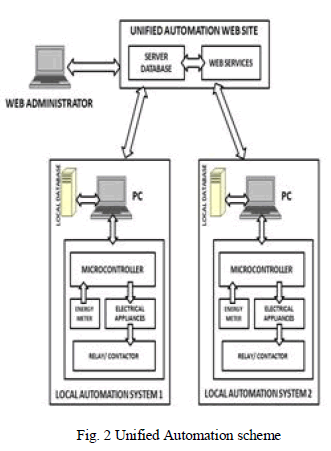 |
A. System Design |
| Fig. 3 shows the system design of the unified local automation system. In local monitoring base station, it has sub modules like hardware configuration, data collection, local database and interface. The functionality of module as follows. |
| Hardware configuration: it provides the interface between the software and automation hardware. It interface is done by common buses like RS-232, USB, GPIO. The drivers used are the system driver no special firmware where used here. The phase includes the work which supports the Windows platform. |
| Data collection: it provides the framework to collect the data from each node in the automation device. The data collected are queried into local database. |
| Local database: it is used to store data collected. Local database deployed using SQL SERVER 2008 |
B. Web service |
| Website of the system holds the sub modules similar the local monitoring base station. All the modules are deploying over the internet hosting. The functionality of each module is described below User management service: it runs the web page where the user can add new user, edit the profile of user. Unified display service: it include service for displaying the data from automation node of each user. Configuration service: it runs a web service where user can edit device type, interface method with the middleware. Web administration service: it is dedicated to web administrated can view the critical information web service runs. In each web service it runs database at the backend the administrator hold the role definition to change edit the database related operation. |
| Database: it runs SQL SERVER 2008 R2. It pulls data from each local database and store to corresponding user table. |
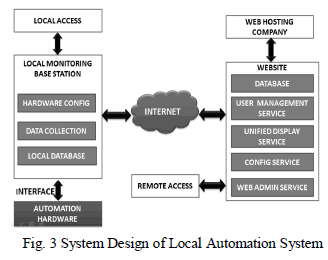 |
C. User Access definition |
| fig 4.3 shows the UML diagram of the user access definition model of local user, remote user and management user. Local user access the hardware and changes made entered to the local database. Remote user access the home through the internet, the remote database get the information of the home through the local database, the remote user have to cross the user login authentication. The management user deals with the management of the website and its service. |
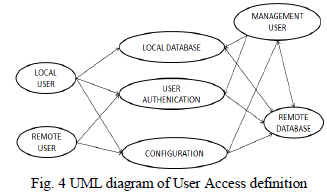 |
D. Mechanism for Non-Queried data |
| The data is fetched from each of the node through the internet. If the loss in the internet leads to the data loss from the local database to main database. In this project, it includes the work simple insert mechanism from the middleware standalone module. The complete methodology includes SSIS integration process is useful in data migration. Fig 5 shows the data fetching model from local to remote database |
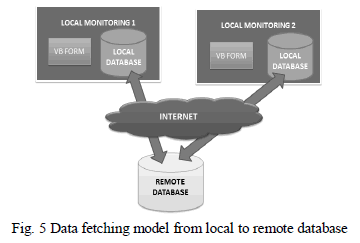 |
E. Layer wise Architecture Implementation |
| Fig. 6 shows the implementation of the design discussed in previously. The software tools and the corresponding layer of the design are shown in the figure. The sub module of the local monitoring base station is implemented in VISUAL BASIC 2010. The sub model of web service is implanted in VISUAL STUDIO 2010. |
 |
INVESTIGATIONAL STUDY |
A. Hardware |
| In order to validate the functionality of the software and web service, prototype hardware is simulated using the Proteus ISIS7 software tools. The simulation includes PIC16F877a microcontroller, where four devices are connected represented with the LED in simulation. Fig. 7 shows the simulation result obtained. The simulation result show the virtual serial port which is paired via VSPE with the standalone module |
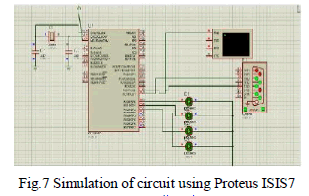 |
B. Middleware |
| The standalone module for hardware interfacing was developed in visual basic 2010. Fig. 8 shows the middleware of home automation system, in which the user need of login provided by the web service for access the local database and main database to log the status of the monitoring system. This phase of work, the user login and status windows are deployed. Hardware interface is done by RS-232 port we use VSPE (Virtual serial port emulator) it run virtual serial port pair. |
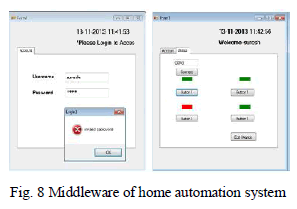 |
C. Website |
| The website are hosted on the server, it run the service each service take the reference of WCF web service to extract, update and display the contents of user. Fig. 9 shows the new user creation and user login module that runs on the server. |
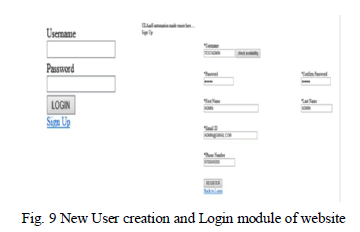 |
CONCLUSION |
| In this paper, a unified local automation has been developed by running different web service like database service, user management service, unified display service, configuration service and web admin service are implemented and the functionality of each service is validated. In this data migration from local database to main database that are left due to network failure or power failure that is achieved by SSIS integration. The website is hosted with the commercial web hosting company; the web site is shared with multiple users which make the running cost as low. With help of the archetype hardware the household appliances are controlled through the internet more easily. |
| The open source automation system and website give the end users a very feasible and reliable automation at low cost. In this paper the security consideration such as password management and hardware key authentication are done. In future complete automation system for both small scale and large scale will be implementation through this integration process. In addition this integration can be done for other database like ORACLE, MYSQL. |
ACKNOWLEDGMENT |
| Thankful to institution, Dept. of EEE, Regional Centre of Anna University, Tirunelveli. I would extend my special word of thanks to all faculty members for their support throughout this work. I express my gratitude to my parents, friends and all other well wishers for their whole hearted support and encouragement during the difficult times of the project work. |
References |
|